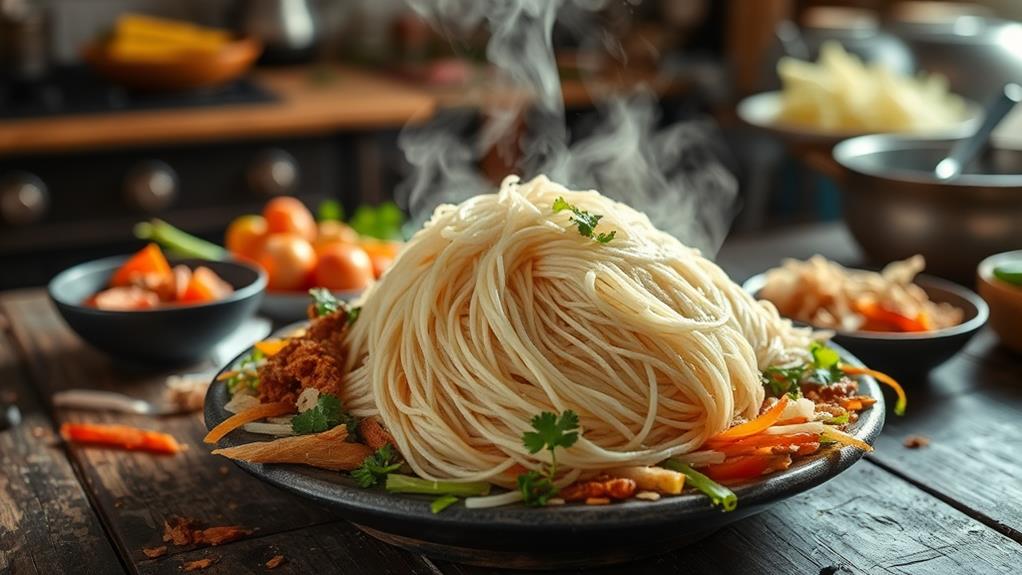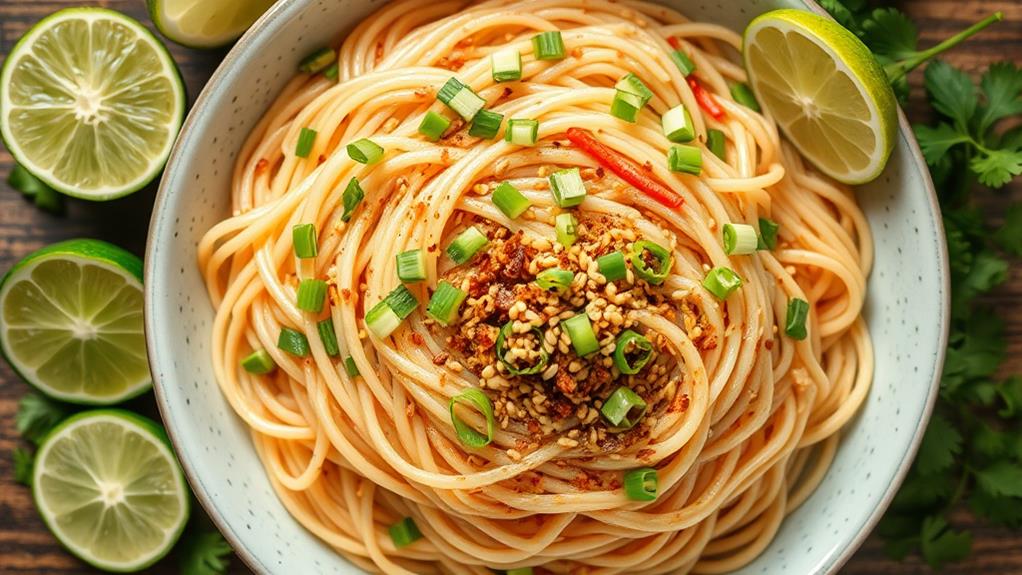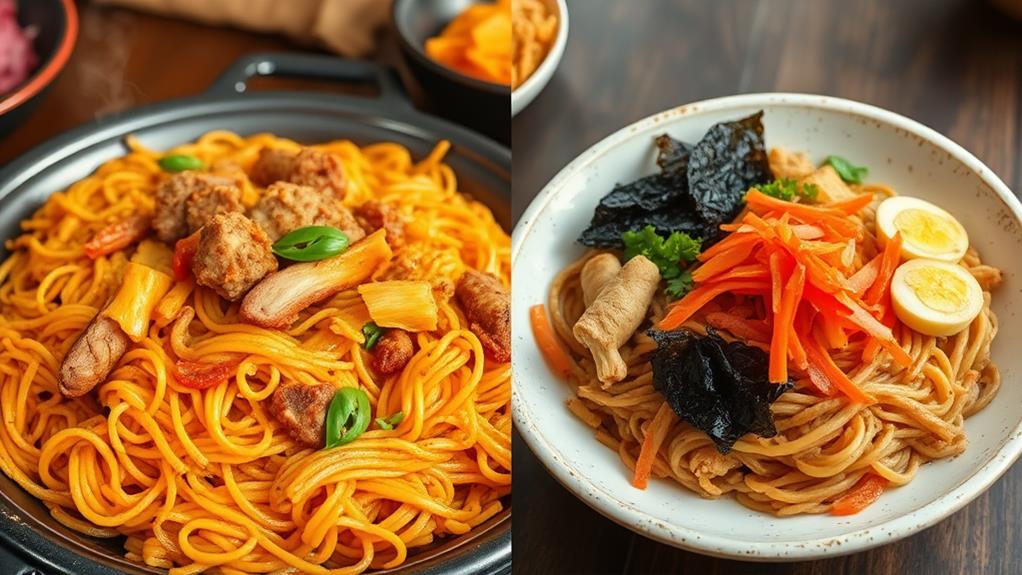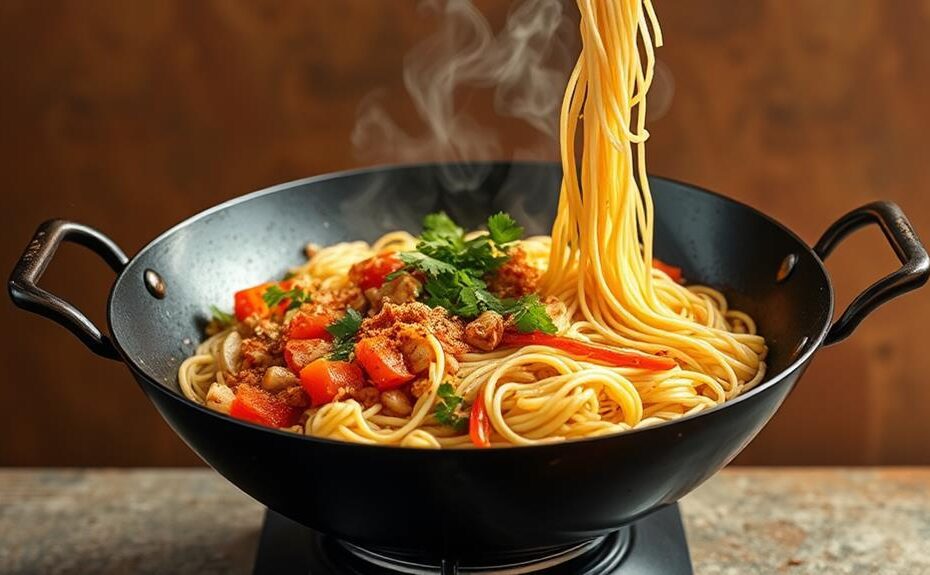Soaking is essential to cook perfect pancit rice noodles. Start by soaking bihon noodles in warm water for 8-10 minutes to achieve a tender yet firm texture.
Prepare ingredients separately to ensure a harmonious blend of flavors. Cook proteins like chicken or shrimp separately, chop vegetables into bite-sized pieces, and mix your sauce components.
Sautéing is key to preventing overcooking and clumping. Sauté garlic and onions in oil, then add your vegetables.
Finally, combine the soaked noodles with the sauce mixture, and brief stir-frying over high heat will help achieve the perfect texture.
By following these steps, you'll be well on your way to creating a delicious and authentic pancit dish.
Understanding Pancit Basics

Understanding Pancit Basics
Soaking and Cooking Bihon Noodles
Bihon noodles require a unique soaking process: they need to soak in warm water for 8-10 minutes to become pliable and ready for stir-frying.
Avoid over-soaking, as this can lead to a mushy texture during cooking. The goal is to achieve a tender yet firm texture, perfect for absorbing the flavors of your dish.
Choosing the Right Noodle Type
Pancit offers various noodle types, including bihon, canton, and malabon, each with a distinct texture and flavor.
Bihon noodles are the most common type, known for their soft and delicate texture.
Elevating Flavor with Broth or Sauce
Incorporate a flavorful broth or sauce while cooking the noodles to elevate the flavor profile.
This allows the noodles to absorb the dish's overall flavor, creating a harmonious balance of taste and texture.
Choosing the Right Noodles
Choosing the Right Noodles for Your Pancit Dish
Traditional Option: Bihon Noodles
When selecting noodles for your pancit dish, bihon noodles are a popular choice due to their thin, rice vermicelli texture that only requires soaking in warm water to soften.
Alternative Noodle Options
Consider canton noodles, which are thick wheat noodles, and Malabon noodles, which are thick rice noodles with seafood, as they provide different textures and flavor profiles.
Gluten-Free Option
Rice noodles are gluten-free, making them suitable for those with gluten sensitivities.
Impact of Noodle Choice on Dish Quality
The choice of noodle significantly impacts the overall dish quality, as the texture and absorption of sauce vary among different types.
Cooking Instructions
Always check the cooking instructions on the noodle package, as preparation times can differ based on the type of noodle used.
Preparing Pancit Ingredients

Pancit Ingredients Preparation
Soaking Noodles: To prepare pancit ingredients, start by soaking bihon rice noodles in warm water for 8-10 minutes until they're softened. This eliminates the need for boiling and helps maintain their texture.
Cooking Proteins: Next, cook your proteins like chicken, pork, or shrimp separately until they're browned or just done. This enhances their flavor and texture when you add them to the dish.
Chopping Vegetables: Chop vegetables like garlic, onion, cabbage, and carrots into bite-sized pieces to ensure they cook quickly and evenly during the stir-frying process.
Mixing Sauce: Mix the sauce components, including soy sauce, oyster sauce, and chicken bouillon, to create a flavorful base that complements the noodles and vegetables.
Preparation Check: Finally, ensure all your ingredients are ready to go before starting the cooking process.
Stir-frying is a quick method that requires constant attention to avoid burning, so it's essential to have everything prepared and within reach.
Cooking Pancit to Perfection
Cooking Pancit to Perfection Requires Attention to Detail
Cooking pancit to perfection involves a combination of technique and attention to detail, as it requires harmonizing flavors and textures. The key to achieving this harmony starts with cooking the rice noodles correctly.
Soaking the Noodles
To cook the noodles correctly, soak the bihon rice noodles in warm water for 8-10 minutes until they're soft but not mushy. This step is crucial, as it affects the texture of the final dish.
Pre-Cooking Protein
Pre-cook your protein of choice, such as pork or shrimp, to enhance their flavor and texture. This step allows the protein to absorb the flavors of the dish evenly.
Creating a Fragrant Base
Sauté garlic and onions in oil to create a fragrant base, which serves as the foundation of the dish.
Add vegetables like cabbage and carrots to achieve a balanced texture.
Combining Flavors
Pour in a mixture of soy sauce, chicken bouillon, and other seasonings while incorporating the soaked noodles, allowing them to absorb the flavors evenly.
This step ensures that the noodles absorb the flavors of the dish, resulting in a harmonious balance of flavors and textures.
Serving and Garnishing Options

Elevate Your Pancit Presentation
Serving pancit noodles on a large platter instead of individual bowls creates a communal dining experience reminiscent of traditional Filipino gatherings. This setup encourages socializing and sharing, making the meal more enjoyable.
It's an effective way to bring people together and foster a sense of community.
Add Flavor and Visual Appeal with Garnishes
Garnishing pancit with fresh lemon or calamansi wedges adds an extra layer of flavor and visual appeal.
The citrus wedges enhance the taste and add a pop of color to the dish.
Chopped green onions or fried shallots can also be used as toppings to add texture and visual appeal.
These garnishes provide a refreshing contrast to the savory noodles.
Pair with Traditional Sides for a Well-Rounded Meal
Serving pancit with traditional sides like lumpia or egg rolls provides a variety of flavors and textures.
This combination creates a well-rounded and visually appealing meal that's sure to impress.
Storing and Reheating Tips
Proper Storage of Cooked Pancit Rice Noodles
To maintain the freshness and texture of cooked pancit rice noodles, store them in an airtight container in the refrigerator for up to 4 days. This prevents spoilage and keeps the noodles fresh for a longer period.
Long-Term Storage
For longer storage, freeze leftover pancit noodles in an airtight container for up to 3 months. Ensure the noodles are well-wrapped to prevent freezer burn.
Reheating Cooked Pancit Rice Noodles
To reheat frozen pancit noodles, thaw them overnight in the refrigerator for best results, allowing for even warming without compromising texture.
Reheat gently in a pan over low heat, adding a splash of water or broth to prevent the noodles from drying out and to help restore moisture.
Consuming Leftovers
Consume leftovers within a few days for optimal quality, and avoid reheating multiple times to prevent loss of texture and flavor.
Exploring Recipe Variations

Pancit rice noodles offer endless versatility, allowing you to experiment with different types of noodles, such as canton or malabon, to alter the texture and flavor profile of your dish.
When cooking Pancit Bihon, soak the rice noodles in warm water for 8-10 minutes to achieve the perfect texture.
Adding stir-fried vegetables enhances nutritional value and allows for customization. You can use carrots, cabbage, and snow peas, which can be substituted with seasonal produce.
Protein variations are also customizable, with options including shrimp, chicken, pork, or vegetarian adaptations with tofu or no meat at all.
The sauce components offer the most creative freedom, where you can combine ingredients like oyster sauce, soy sauce, and calamansi juice to create unique flavor profiles.
Using chicken broth as a base, you can adjust the seasoning to suit your taste, making each Filipino recipe truly your own.
Can I Use Different Types of Noodles for Pancit Recipes?
Yes, you can use different types of noodles for easy filipino pancit recipes. Pancit recipes traditionally use rice noodles, but you can also try using egg noodles, udon noodles, or even spaghetti for a unique twist. Experiment with different noodle types to find your favorite combination for easy Filipino pancit recipes.
Common Cooking Mistakes
Avoiding Common Mistakes When Cooking Pancit Rice Noodles
To achieve the perfect texture and flavor in Pancit rice noodles, it's essential to avoid common mistakes that can ruin the dish.
Boiling Instead of Soaking
Boiling rice noodles can lead to a mushy texture. Instead, soak them in warm water to achieve the desired chewy consistency.
Insufficient Soaking Time
Failing to allow sufficient time for the noodles to soak can result in undercooked noodles that don't absorb flavors properly. Soak the noodles for 8-10 minutes to ensure they cook evenly.
Overcooking During Stir-Frying
Overcooking the noodles during stir-frying can cause them to clump together and lose their shape. Stir-fry the noodles briefly to prevent them from becoming sticky and unappetizing.
Failing to Rinse Soaked Noodles
Failing to rinse the soaked noodles can leave excess starch, leading to a sticky finish. Rinse the noodles after soaking to remove excess starch and achieve a better texture.
Additionally, add the noodles to the stir-fry at the right time to prevent them from becoming soggy or too dry.
Frequently Asked Questions
How Should Rice Noodles Be Cooked?
To cook rice noodles, soak them in warm water for 8-10 minutes. This step helps rehydrate the noodles and makes them pliable for cooking.
After soaking, drain and rinse the noodles under cold water to remove excess starch and prevent sticking.
Avoid boiling rice noodles, as high heat can break down their structure and make them mushy. Instead, gently toss the noodles with your stir-fry ingredients towards the end of cooking to allow them to absorb flavors. This helps the noodles integrate with the dish and prevents them from becoming a separate, flavorless component.
Mixing rice noodles with a savory sauce can add depth of flavor. This is especially true for Asian-inspired dishes, where the noodles can absorb the flavors of sauces like soy sauce, oyster sauce, or fish sauce.
Why Do You Soak Rice Noodles Before Cooking?
Soaking rice noodles before cooking maintains their texture and enhances flavor absorption.
Soaking prevents noodles from becoming mushy during cooking, allowing them to retain their ideal texture.
It also reduces cooking time, making the overall cooking process more efficient.
Furthermore, soaking enables noodles to absorb flavors more effectively, resulting in a more savory dish.
This preparation method is crucial in traditional recipes, such as pancit, to achieve the perfect balance of texture and flavor.
What Kind of Noodles Are Used in Pancit?
Traditionally, pancit is made with bihon noodles, which are thin rice vermicelli noodles that absorb flavors well. These noodles are ideal for pancit because of their ability to soak up the savory flavors of the dish.
If you want to experiment with different textures and tastes, you can use canton noodles or Malabon noodles as alternatives. These noodles have distinct characteristics that can alter the overall experience of eating pancit.
For a more adventurous twist, udon noodles or chow mein noodles can be used. These noodles have thicker, chewier textures that can add a new dimension to the classic dish.
How to Cook Rice Noodles for Pho?
Cooking Rice Noodles for Pho
To achieve the perfect texture, soak rice noodles in warm water for about 30 minutes. This soaking process helps to rehydrate the noodles and makes them pliable.
After soaking, briefly blanch the noodles in boiling water for 30 seconds to heat them through. This step is crucial to ensure the noodles are cooked evenly and prevents them from becoming mushy.
Drain the noodles thoroughly to prevent clumping. This is an essential step to maintain the texture and appearance of the noodles in the final dish.
Once cooked and drained, the rice noodles are ready to be served in a steaming bowl of pho broth.
Garnish with fresh herbs, bean sprouts, and lime wedges to enhance the flavor and aroma of the dish.
